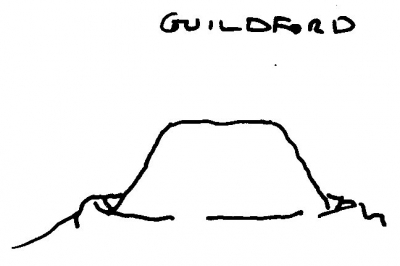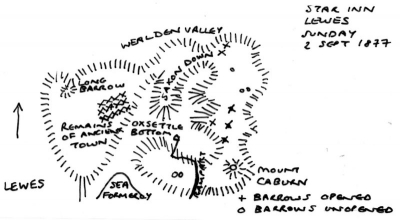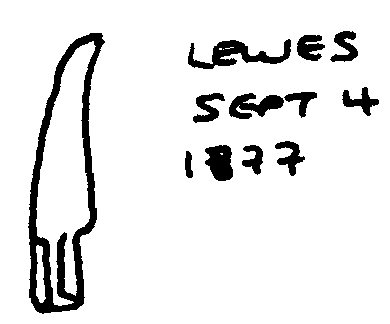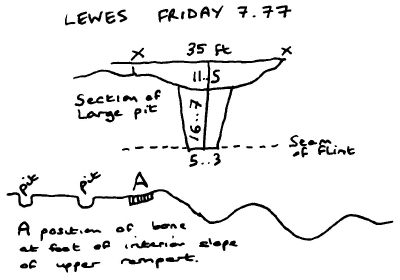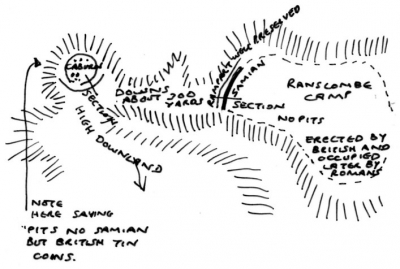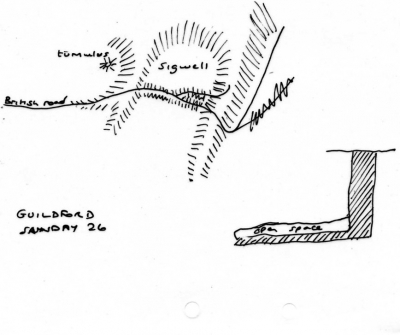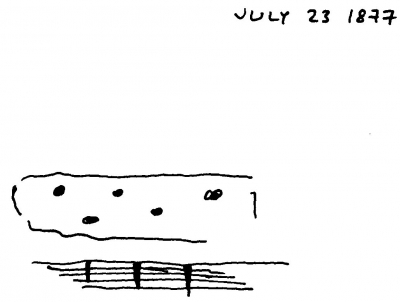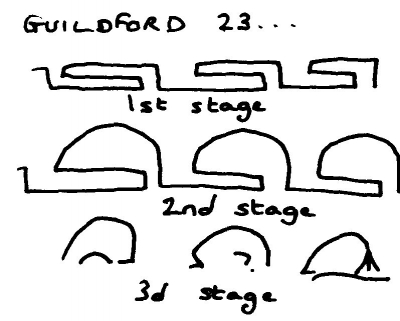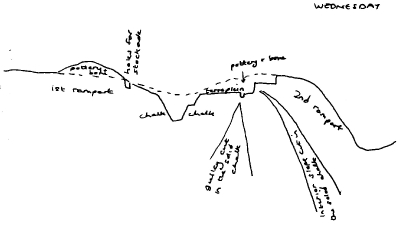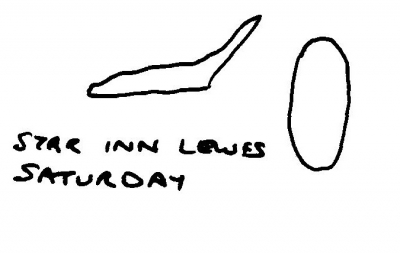To search the RPR site click here
Part of the Ashmolean Museum (Dept of Antiquities) manuscript collections.
Copyright Ashmolean Museum, University of Oxford. This email address is being protected from spambots. You need JavaScript enabled to view it." title="This will launch your email program" style="border-color: #666666; color: #666666;">
The letters were not numbered at the time of transcription, they did appear to be some predetermined order (though it was not clear what that was) and there was a note on the cover of the envelop indicating that the letters were dated 1876-1878 and from Lane Fox, though it is not clear who wrote this, when or based on what information, it is therefore not clear what has driven the order of the letters (they were not found in date order).
The transcriptions are not shown in the original letter order because it was clear from evidence in the letters or else from the small amount of additional research that I carried out that some of them at least could be placed in date order. Therefore those that can be dated, are at the beginning and undated and undateable (for now) ones are at the end. All the letters’ endnotes are numbered within each letter to make rearranging to order easier.
Note that the images shown on this page are scans of tracings prepared by the transcriber using perspex and tracing paper. They are therefore to scale (within the illustration) but the way the text laps around the drawings cannot be seen. It is to be hoped that the Ashmolean Museum will scan this archive at some point and make the scans available over the web. Please also note that Lane Fox was very skilled at small neat[ish] writing, which the transcriber was unable to match but the writing is shown in roughly the right place on the illustration. No attempt has been made to copy Lane Fox's handwriting.
George Rolleston (1829-1881) was a close friend and colleague's of Lane Fox. During the 1870s he was Linacre professor of anatomy and physiology, University of Oxford. He was a very keen archaeologist working with Lane Fox on several different projects. It is not known why this correspondence appears to date from only 3 years and specifically that most of it relates to their joint interest in Mount Caburn and Ranscombe Camp in Sussex. Presumably it formed part of a larger series of letters kept by Rolleston from Lane Fox, but the whereabouts of the rest of the letters is not known, and they may not have survived.
A. Petch
Please note that a full catalogue of the Rolleston papers held by the Ashmolean Museum is now available here.
---
Guildford
Aug 24th 76
[Printed header] Anthropological Institute / of Great Britain & Ireland / 4, St Martins Place W.C. / … 187 …]
Dear Prof Rolleston
I understand they [insert] ie the spiritualists [end insert] have sent you an invitation to go & see this exhibition of Mr Slades [1] If you do go notice some points that attracted my attention today when I went.
this writing on the slate is evidently done by the small fragment of slate pencil which is put on the slate, and whilst the slate is under the table. Without doing anything, I noticed the position of the fragment of pencil at the time he put it under the table and also immediately after it was taken up with the writing on it & I found that it [insert] had changed and [end insert] settled on the end of the last stroke of the writing thus for example one of the answers written was “he is not *” and the fragment of slate was in the position in which I have marked the * this convinces me that the slate is not charged but that the writing is done in some ways whilst it is under the table and by the piece of pencil.
I also noticed that the appearance of the hand was in a position in which Mr Slade’s hand would naturally have appeared if he pushed it forward and up from under the table the appearance was so ...mentally [?] that it might well have been done in this way. also notice the carpet under the table to see if any thing can be shoved up from the floor.
It is I think worth investigating as many people are being bamboozled by it.
Yours sincerely
A Lane Fox
[1] Henry Slade (1835-1905, prosecuted for fraud in October 1876 and found guilty. His first séance in UK was held in July 1876, his ‘trick’ was that ‘messages were written inside double slates, sometimes tied and sealed together, while they either lay upon the table in full view of all, or were laid upon the heads of members of the committee, or held flat against the under surface of the table-top, or held in a committeeman's hand without the medium touching it.’ [http://www.spiritualist.tv/spiritualism/history/vol1chapter13.html] Same source says ‘Directly after his arrival in London Slade began to give sittings at his lodgings in 8 Upper Bedford Place, Russell Square, and his success was immediate and pronounced.’ At his first séance in England, according to same source, ‘Slade put a tiny piece of pencil, about the size of a grain of wheat, upon a slate, and held the slate by one corner with one hand under the table flat against the leaf. Writing was heard on the slate, and on examination a short message was found to have been written. While this was taking place the four hands of the sitters and Slade's disengaged hands were clasped in the centre of the table.’ It was Professor Ray Lankester who exposed him early in September 1876.
----
Guildford
August 29th 1876
Dear Professor Rolleston
I am sorry you did not go the subject whether it be all quackery or partly quackery or partly insanity or partly true is doubtless an important one for anthropology. I should not have thought the subject worth investigating had it not been for the proof I have of unconscious writing in my own family where I know there is no deception. I have seen it proved over & over again thus some of my children do write unconsciously full & connective answers to questions put to them altho they are in no way given to unconscious action at other times and further I have proved that two or more acting in concert produces a more intense manifestation of the phenomenon [insert] whatever it is [end insert] than when it is done singly, consequently it cant be the unconscious action of one mind, in fact in the case of my children one of them cannot do it alone and this is what puzzles me. I should have liked much to have heard your opinion on the subject as you are not biased towards either side. I met Professor Barrett [1] there and have twice written to him my opinion to what I saw. I think the subject ought to be brought forward & discussed by good men. Certainly nothing I saw at Mr Slade’s impressed me so much as what I have seen done at home.
I have another idea in my head just now which I should like you to think of & let me known your opinion at some future time, it is this. now that there is a prospect of our having to fight again in Dahomy [2] I want the British association to petition Government that in future a scientific commission should be attached to all armies in the field. that the arbitrary power necessarily possessed by belligerents should be utilised for the purpose of carrying on investigations which cannot without great time & difficulty be considered in time of peace. In an enemy country or even in a friendly country in time of war private property can be entered upon, excavations made, inhabitants measured & statistics obtained under compulsion prisoners of war may be employed in forced labour & so forth. one of the most important functions of such a commission would be the preservation of ancient monuments [insert] museums [end insert] & other objects of scientific interest which have suffered so much from wars in times past.
As it would of course be necessary that such a commission should act in harmony with the military operators I would propose to place it under the direction of a competent military officer who would be attached to the staff of the army & thus bring it under the orders of the Officer Commanding in chief, the military [illegible P…] of the Scientific commission would direct the different [illegible] & provide proper escort & transport &c the various [illegible, same word as last illegible one] would of course depend on the nature of the country whether civilised or uncivilised & might consist of 1 Topographical – to map out the country if not already one & would consist of Officers of the R Engineers 2 Geological – to follow after the Topographical & scope the country Geologically 3 Anthropological to measure the inhabitants examine antiquities & obtain statistics as to the moral social physical & intellectual condition of the people also to preserve monument &c 4 Zoological 5 Botanical What do you think of the practicality of such a scheme can you offer any suggestions
Yours [illegible]
A Lane Fox
[1] Professor Sir William Fletcher Barrett (1844-1925) Pioneer of psychical research, Professor of Physics at Royal College of Science in Dublin. He gave a talk to the BAAS on the subject.
[2] Blockade of Dahomey, around 25 August 1876 by British ships, arising from the reported ill-treatment of an Englishman resident in Whydah, and the refusal of the King to pay the palm-oil fine levied by the commodore of the station.
-----
Guildford
April 18. 77
Dear Professor Rolleston
There is no knowing what may happen between this & July but if nothing particular, I should like much to dig at the plain you name which I have not seen. I certainly think that the majority of the British forts in Sussex at least must have been made at a time when flint flakes &c were still in use from the number found in them. I am going to dig a round barrow near here in a day or two. Fancy my disgust at losing the urn the shale beads & the two bronze discs from the Black Burgh [1] tumulus shown in figures in the last number of the journal. Franks man took them away from the Institute by mistake with the things from the Camp at Seaford and they cant be found.
Schliemann’s paper at the Antiquaries was not good for much all about “the immortal Past” & the “King of men” but no attempt to compare the items with those from other localities the photograph was only exhibited in part [?], for a short time & no one has been allowed to see this since but it was evident that the masks diadems? &c are of the thinnest gold & resemble the objects found in the graves at Cyprus. The masks being like those from Kouyunjik [2] (Nineveh) he could not tell me whether the bronze spear heads &c had cast sockets or sockets at all but from the photographs they appeared to be all tanged like those from Cyprus they are [illegible] quite genuine however & all but the coil ornaments appeared to me to resemble Cyprian art. I expect we shall occupy the Holy Land and Crete & perhaps Greece but I cant see that we have any business at Constantinople which ought to be left for Russia Austria & Italy to squabble about. [3] There will be good digging to be done in Crete. If I were a believer in dreams, which of course I am not, I had a very particular one 20 years ago that I was to be sent to fortify Jerusalem! It has always been a subject of chaff at home as to how the dream was to be fulfilled who knows. If the Russians operate by the side of Persia that is strategically the point we should occupy to cover the canal. I suspect we shall have Egypt some day meanwhile we must help the Greeks
Yours [illegible]
A Lane Fox
By the way Park Harrison [4] has been in a great state of mind about his Cissbury marks he has discovered that they are all runes and that the characters are perfectly intelligible & can be easily read, which as he justly says is a most remarkable thing, he has sent drawings to all the best authorities and has been assured by them that they are extremely interesting & in short there is no holding him
[1] Black Burgh: Lane Fox’s excavation near Brighton
[2] Ancient Nineveh’s mound-ruin of Kouyunjik, according to Wikipedia
[3] Constantinople: The Constantinople Conference of 1876-1877 was a meeting of the 'Great Powers' of Britain, Russia, France, Germany, Austria-Hungary and Italy to try and bring peace to the region. The conference ended in January 1877, three months before this letter was written and was followed by the Russo-Turkish war of 1877-1878. Crete was been involved because of the revolt of 1866-1869 against the Ottoman Empire of which it still formed part.
[4] James Park Harrison (1817-1901) Victorian architect, by 1851 he had largely retired and devoted himself to ethnographic and archaeological studies. See http://www.sussexparishchurches.org/content/view/329/40. This is presumably connected with Cissbury: see http://england.prm.ox.ac.uk/englishness-Pitt-Rivers-Cissbury-Sussex.html and [Bowden, 1991: 77-81] PR worked at Cissbury in 1867, 1875 and 1877.
---
Guildford
Dear Professor Rolleston
I am sorry you cant come I was asked to go to Lord Bathurst’s [1] for the Cirencester meeting but I have to be here for some duty and must start on Thursday for Lewes to help the plans in preparation for work on the 3rd as I suppose I shall be alone for the first few days. One cant do plans & superintend the digging at the same time I dare say your meeting will be very pleasant but you had much better come to Lewes, real work is of much more consequence than tumbling upon a platform for the amusement of a country audience I cant tumble on I dare say I might enjoy it, but unmittigated [sic] luncheon with distinguished archaeologist honorable gentlemen & noble Lord, dont do much to make anthropology a science in my humble judgement our programme will include the opening of a long barrow near Mount Caburn and you will have to come baby or no baby. [2] tho I admit it is well to be at home on occasions of that kind but there will be bones.
I am going to take 6 weeks leave & shall devote the whole of it to digging. I found a very good flake in the drift of the Axe [3] the other day after walking 6 miles along the gravel on the railway and a good core since then I have been staying with the Ponsonbys at Brympton [4] near Yeovil & have seen a good Camp. I find the pits in Montacute mont-acute is very strongly fortified [?] in the shape of a sharp cone [Drawing] but cant make out at what period
Yours [illegible]
A Lane Fox
[1] Probably William Bathurst, 5th Earl Bathursh (1791-1878), peer and civil servant.
[2] Rolleston had 7 or 8 children [depending on which source you trust] but I have not been able to find out the dates of them except for his eldest son born 1862, and a younger son born 1873. So that doesn’t help dating letter.
[3] Lane Fox was at BAAS meeting at Plymouth on August 18-21. So perhaps this letter dates after 21 August [when he might have returned via the Axe Valley in Devon] but before 2 September when he started digging at Mount Caburn etc.
[4] Brympton d’Evercy near Yeovil see http://en.wikipedia.org/wiki/Brympton_d%27Evercy. The Ponsonbys were the Honorable Spencer Ponsonby later Ponsonby-Fane (1824-1915), civil servant who worked in Foreign Office, who inherited the house in 1874. See http://en.wikipedia.org/wiki/Spencer_Ponsonby-Fane
----
Star Inn
Lewes
Sunday 2nd [insert] Sept [end insert] 77
Dear Professor Rolleston
I have been here two days marking down all the antiquities in the neighbourhood of Mount Caburn on the 25 inch map. The whole cluster of hills is almost in its primeval condition no cultivation having taken place since prehistoric times when it was highly cultivated in small enclosures & terraces of considerable size, we have here to do not so much with the remains of the dead as with vestiges of the living inhabitants of the district. the cluster of hills standing by themselves [2 words crossed out] isolated from the neighbouring hills & fortified by nature all round. with access through one valley with what was then sea appears to have been very thickly inhabited and probably by two hostile tribes or people. now there is not a house on it [Drawing annotated ‘Wealden Valley’ ‘Long barrow’ ‘Remains of ancient town’ ‘Lewes’ ‘Sea formerly’ ‘Mount Caburn’ ‘Saxon Down’ ‘Ox settle bottom’ ‘rampart’ ‘+ Barrows opened’ ‘o Barrows unopened’]
the interior of Mount Caburn is filled with 50 hut circles which are to be opened remains of British pottery are to be seen on the surface in places where the earth has been scratched. outside there are about 5 round barrows unopened & may [sic, missing ‘be’] more which were opened by Dr Mantell [1] who found both Saxon & British remains the barrows here are some of them single [?] being simple circles consisting of a slight ditch with scarcely any mound [Drawing]
On the top of one I found where the earth had been scratched small fragments of Saxon unglazed pottery with fragments having glaze upon it and iron nails. to the west of Mount Caburn is an entrenchmt [sic] thrown up across the hill against Mount Caburn and behind it further to the west are the remains of a great number of rectangular enclosures probably a town & possibly Saxon as the down on which they stand is called Saxon down. It seems as if the Saxons or whoever they were had entrenched themselves against Mount Caburn which was occupied by the British. This however is of course conjecture until we have determined by digging to what people the several works belong, further to the west is a long barrow which has never I think been properly opened I have difficulty about men Dr [illegible] Ward who engaged 5 men for me I find has had what he calls a head attack and has entirely lost his memory, and the people he engaged have thrown him over, I was close upon giving it up but yesterday succeeded in engaging two stout men. It seems hardly worth while beginning with so few especially as they ask 4 shillings wages here, but the man tells me there is as much difference between a 3 shilling & a 4 shilling man as between a sheep & a goat I thought that was good anthropology so I engaged him hoping that in case you came you might like to examine him.
This place has done me good already far better than the enervating air of Devonshire it is said to be very beneficial to people who have overworked their brain by inventing new & original stories about rats & mice and cockroaches especially cockroaches I will let you know how we get on in a day or two it seems doubtful whether we shall be able to proceed without a sufficient supply of men the Inn is an old house of the time of Charles II more or less thickly populated and you know how soup is made in Sussex.
Yours [illegible]
A L Fox
[1] Gideon Algernon Mantell (1790-1852, obstetrician, geologist and palaeontologist based in Lewes see http://www.oxforddnb.com/view/article/18004
-----
Lewes Sept 4 ‘77
Dear Professor Rolleston
I find that I have been in too great a hurry to announce a second Cissbury I felt quite convinced when I wrote they must be shafts as they went down almost perpendicularly and had all the appearance of Cissbury shafts but this morning we found the bottom. they are evidently pits but for what object so deep I cant make out as they are not long enough for a man to lie down extended they are very interesting however both on account of the objects found in them and the immense quantity of animal bones. I think if I send you the whole of the bones you will be able to form a fair idea of the relative numbers of the differing animals used as food, I am sure every kind of animal of the period must be represented they are of the Iron Age as I found a scale of iron armour at the bottom of one of them and a bill of the British form at the bottom of another [Drawing] the pottery is what we should call Romano British but are we not in the habit of using that term rather promiscuously? do we know much of the Britons of the Iron Age [3 words illegible possibly than who Caesar?] I fancy that must be the period. I found nothing absolutely Roman I had intended to wash and ticket every bone but I find that is quite impossible Shall I send them to you as they are, unwashed, with a general ticket to each box. I would put off the digging for 10 days if I was sure you would come. but there is great difficulty in getting men this month & to dig on the top of the hill in winter would be impossible, it is cold enough now. the men say they cant come again if the break off now [sic]. I wish I had known of your inability to come at this season I fancied somehow that you had approved of the time. I think I had better send you the bones at once day by day as I find them
Yours sincerely
Bug fodder
[4 drawings annotated ‘Iron spud found in one pit’ ‘stone pebble groove’ ‘burnisher’ ‘bone comb’ ‘horn handle’]
----
Lewes
Wednesday
Sept 5th 187 [presumably 1877]
Dear Professor Rolleston
I have sent you off today a hamper containing the following packages
1 Black horn of ox? from Bottom of Pit 1
2 Horn core of Bos from bottom of pit 1.
3 Bones from middle of pit 2. in box these were the only ones I have had time to wash & dry
4. Bones from surface mould of pit 3
5 Bones from bottom of Pit 2.
6 Bones from bottom of Pit 3
7 Bones from Pit 4
You will understand that this classification was made as the excavations went on when there was no knowing what might turn up or what destructions it might be necessary to make before the remains found in different places for example I have separated the remains found in the middle of one of the pits from those found in the bottom but this was at a time when I had reason to suppose they might be deep and empty I have no reason to suppose that there is any difference between the several pits but there may be a difference between the horns found in the surface mould from those in the white chalk filling of the pits.
Helix hortensis [1] has only been found as yet in the surface mould not in the filling Helix nemoralis [1] is abundant in the filling of the pits but not in the surface mould and it does not exist at present any where alive on the downs. the place (Mount Caburn) is remote from all woods or scrub of any kind, down land for some distance round.
Oysters as yet have only been found in the surface mould 5 or 6 have been found in this mould. not in the filling of the pits. but in the large pit (opened since & not included in your packages) oysters are abundant associated with a superior class of pottery which is Roman. I shall send you the bones from the other pits in a day or two.
I find it rather hard work as I have to be on the ground at 8 every morning & to walk 3 miles to it up hill, working after I come home is more than I can manage.
I have classified the pottery in the same way as the bones so that if there is any difference we can compare notes when I have had time to examine the pottery more thoroughly. the pottery as I told you is what we should call Romano British Iron Implements have been found in the bottoms of two pits and the whole is certainly of the iron age.
flakes only 2 or 3 not enough to characterise the objects as they might belong to the soil.
these pits must be considered apart from the surrounding rampart which has to be examined afterwards.
Yours sincerely
Combined Committee
[1] Snail
------
Lewes
Friday 7: 77 [NB this must be Friday 7th September 1877, as dates and days tally]
Dear Professor Rolleston
I have sent you a second package [insert] in a box [end insert] containing bags ticketted [sic] as follows
1. Bone found in upper part of Pit 5 – Sept 5
2. Bones found at Bottom of pit 5. Sept 6th
3 Bones found at bottom of Pit 6
4. Bones found in turn pit Sept 6. found all through but chiefly at Bottom with an iron knife [drawing]
5. Bones found at top of large Pit [Drawing annotated ‘section of large pit’ and ‘seam of flint’ and measurements] only one fragment of bone found at bottom of this pit which being the only relic is sent separately a small [insert] only one inch square [end insert] fragment of pottery was also found at bottom
6 Bones from surface mould at foot of interior slope of upper rampart. these may probably belong to the more recent occupants of the fort & not to the rampart proper [Drawing, annotated ‘A position of bones at foot of interior slope of upper rampart’ and with marked pits] the rest of the rampart is not yet excavated
the large Pit [insert] in the interior of the camp [end insert] may possibly be a flint shaft where the people dug to get flints but finding out a vein of small flints at bottom unsuitable for implements they did not drive galleries or sink any more shafts. this is the only way I can account for this occurrence of a pit of this size with a basin at top, the only one in the camp, it was filled with chalk rubble quite white without any admix [illegible] of surface mould or discolouration [added] no snail shells of any kind in this pit [end addition] of any kind, sides jagged tho circular as at Cissbury, bottom also jagged, vein of small flints in side about 2 or 3 feet from bottom all broken off, loose flints in rubble, small, and all the fractures black, not discoloured, shewing thus the pit must have been filled up again with the rubble taken out of it soon after it was excavated no flakes or cores. But few if any were found in some of the shafts in Cissbury, the piece of bone found at bottom sent separately in a letter a small fragment of pottery one with long also found at bottom nothing else. No marks, only one ancient pick mark
Yours sincerely
A Lane Fox
----
Dear Professor Rolleston
I have sent off the hamper containing the Caburn [insert] and Ranscombe [end insert] bones and now send you the Relic table. I have not been able to make a copy of it as we are all confusion and packing. I found a human jaw in one of the pits that is part of our well formed [illegible] as tolerably proofreading [?] [illegible] It will be well to look over the bones to see if there are any other human but I think not the only other human bone found you told me was in the outer ditchs [sic] Can not you give me a few General remarks on the animal remains both the present lots and the last to add to the paper as from you.
You understand that all labelled [insert] ticketted [sic] [end insert] “Mount Caburn” are from the same camp as those you examine [insert] examined [end insert] before but Ranscombe camp is another camp adjoining only one hill portion of the ramparts of which all now traceable [illegible] that part which faces Mount Caburn within 300 yds. this Ranscombe camp I have ascertained by the excavation was erected by the Britons probably of earlier date than the Caburn but was occupied by the Romans. Quantities of Samian pottery having been found at the foot of the interior slope just under the turf but the rampart and ditch were erected by the Britons because in the body of the Rampart and in the lowest layer of the ditch I found not a single fragment of Roman pottery and several pieces of coarse British. In the upper layer of the ditch and in the silting of the interior slope not a single fragment of coarse British pottery was found In the body of the Rampart I found a stags horn with the British pottery and if I am not mistaken the bones found at the bottom of the ditch beneath a hard [illegible] of silting was the jaws of deer? British pottery was found with these jaws. the evidence is very complete. I assume thus the old British camp [insert] RANSCOMBE [end insert] that is the part of the Rampart of it while faces Caburn was occupied by the Romans during an attack on the late Celtic fortress at Caburn. You remember that no Samian pottery was found in the Caburn except a small fragment quite on the surface [Drawing of camps, annotated ‘Caburn’ ‘Ranscombe Camp no pits erected by British and occupied later by Romans’ ‘Ramparts scarcely traceable’ ‘Rampart well preserved’ ‘Samian’ ‘Downs about 300 yards’ ‘High Downland’ ‘Section’ and ‘’Pits no Samian but British tin coins’] I leave this for good on the 27 or 28 [1] & should like to have the Relic table back before if possible
Yours sincerely
A Lane Fox
[1] Possibly October 27-28 1877 when PR was working at Mount Caburn and Ranscombe?
----
[Printed] Steyne Hotel / Worthing / Sussex
Oct 27. 77
Dear Professor Rolleston
I have seen Park Harrison digging & find that he has no grounds whatever for a cemetery or graves of any kind. In digging to find another flint shaft he accidentally came across some small pits about 4..6 deep, similar in all respects to those of Mount Caburn and having a few animal bones in them but no human bones either burnt or unburnt. the place also is a very unlikely one for a cemetery being in the interior of the camp the pits however are interesting from their exact resemblance to those of Mount Caburn. he has found in them an Iron reaping hook [Drawing] several fragments of combs exactly similar to the one found by me and pottery ornamented in exactly similar fashion viz with broad incised grooves resembling the urn I pointed out to you at Oxford but what is most interesting in one of the pits he found 2 pieces of clay impressed with the marks of wattles which he could make nothing of but which from having found a quantity of them in Mount Caburn I was able at once to recognise as the clay with which a british hut had been plastered on the outside such fragments usually perish and leave no trace but at Mount Caburn they were preserved by having had the second rampart thrown over them when they were fresh and at Cissbury the two fragments were preserved by having been burnt. no stronger evidence could be had that the pits in question were of the british huts or the latrines connected with huts with which all manner of refuse was put as to the new shafts & galleries they are simply a repetition of what has been found before except that there are little or no animal remains & fewer objects of interest but of course Harrison has the spot where a man broke his neck another where he was stopped by being frightened by a ghost, one block of chalk is an idol and so forth.
By the way I only brought away the paper with the new set of bones identified will you send me the others
also will you kindly look to the three tin boxes containing soil from the pits & let me know whether there is any trace of phosphate s------ or anything to lead to the supposition that they were latrines. the finding of so many animal bones as you have seen in all the pits with no trace of any thing human is proof positive that they were not graves
Yours sincerely
A Lane Fox
P.S. I return to Guildford today
-----
[Printed] Anthropological Institute / of Great Britain & Ireland / 4 St Martin’s Place W.C.
Dec 21 1877
Dear Professor Rolleston
Many thanks for the paper on the examination of the earth. I will endeavour to get some more earth as soon as I am able to go back to Lewes. Greenwell [1] did not send me his book [2] but I shall be delighted to have a copy
Yours [illegible]
A Lane Fox
[1] Canon Greenwell
[2] British Barrows, written with Rolleston, Lane Fox did have one in his library so presumably Rolleston sent him his copy.
------
Guildford
Sunday 26 [May 1878, see [3]]
Dear Professor Rolleston
Please send me back my remarks on Cadbury. I want to hedge my opinion as to the Camp at Sigwell [sic] [1] and to mention an alternative theory which I occurred to me at the time and which I think might as [sic] be mentioned tho I dont think much of it viz that the ditch at Sigwell may not be the ditch of a camp at all but part of the old British road running along the top of the hill & sunk to the level of the then bottom of the ravines the ravines must have got a good deal deeper since by denudation whereas the ditch or road being at right angles would retain its old depth on this view of the matter the small ditch at the north end cut back out of the other would be the branch track going down the ravine to the water whilst the main road went on over the ravine & on to the other camp which certainly is a camp. [Drawing annotated ‘Sigwell’ ‘tumulus’ ‘British road’]
I dont think much of this idea but it may be as well to mention it instead of allowing it to be brought up in opposition afterwards by an ‘enemy’ or a ‘patient’ [Added] It would topple over the hide [?] theory based upon Sigwell being a camp, bronze period & all [end addition] What do you wish me to do with my small plans which are made to a scale expressly for you to go into the journal. Shall I send them to you or that of course you wont have any false modesty about using them I dont look upon you as an ‘enemy’ or a ‘patient’ altho I regard Boreas [2] in the light of both on account of his tiresome crotchets. By the way I dont take to the idea of Evans remarks on Boreas's first paper. he says the Cissbury shafts could not have been filled up quickly because there are stalactites in the galleries.
I rather doubt the stalactites, not having seen any, but if there were the shafts were filled up were filled up [sic] from the chalk from the next pit just as in digging one throws the earth from one spadeful into the hole made by the previous spade thrust. that is the only way they had of getting rid of the earth, as a sergeant of sappers very truly observed to me on the spot. the chalk from a a [sic] new small pit would not fill a previously opened large one & so the large one remained half filled for some little time & the soil washed in & any one who died might be buried in the bottom. afterwards when they sunk another shaft they completed the filling of the first up to the top leaving the body below but the galleries were never filled up. we found space enough to crawl along in all of them when first opened & this space would be enough to allow stalagtites [sic] to be formed in. How much air is necessary to enable stalagtites to formed? [sic] I should like your opinion on this point. tho I doubt the existence of stalagtites unless you saw them. Hilton Price & I are going to dig in the Folkestone camp on the 4th [3] & I dont know how we are to get rid of Boreas [Drawing annotated ‘open space’]
Yours very truly
A Lane Fox
Enclosure
July 23 1877
Examined camp at Charwell [4] and also trace of lump on hill beyond. Commenced digging tumulus to S.W. of Sigwell Camp. Cut a trench 17 feet long & 12..6 wide on line A.B. of plan and to the SW of centre picket found a well formed scraper 4..7 below the level of centre picket and 3..5 to the SW of it
Examined trace of camp on Beacon Hill [5]
returned to tumulus, very wet day, burnt body found exactly beneath centre picket. it occupied a sphere of 1 post diameter & the top of it was 6 feet beneath centre picket. beneath it was a thick seam of burnt wood 4 inches thick the top of which was 1..9 beneath top of burnt body, the burnt body consequently was separated from the layer of charcoal by about 9 inches of sand, the body itself occupying 1 foot, & being itself mixed with sand. Immediately beneath the layer of burnt wood the brown line of the old turf surface was found the top of which was from 7..9 to 8 feet beneath the centre picket. this extended over the whole of the area excavated, & in cutting horizontal layer where section through it the round section of the stems of grass could be distinctly seen. [drawing] beneath this about 6 inches the yellow natural soil was found as in the preceding twin [? Possibly ‘turn’] barrow. In cutting horizontal section with the shovel in this natural soil, beneath the place where the burnt wood had been found above, the round section of small stakes about 1 inch in diameter could be seen extending for 6 or 7 inches into the natural soil where they had been driven in to keep the wood of the funeral pile together [Drawing] [Added] See also Greenwells discovery of stakes in Yorkshire [end addition] some of them appeared [drawing shown as second illustration in first illustration attached to letter Guildford Sunday 26th] to get smaller towards th [sic – ‘the’] bottom where the points of the stakes had been a chipped flint disc 2 1/2 inch in diameter, chipped on both sides was found in the centre of the burnt [added] wood [end addition] such a stone might have been used as a sling stone with a riband sling. some of fragments of the burnt body were forced lower down amongst the burnt wood these may have been fragments which escaped the notice of the people when they collected the others, The burnt body appears to have been put together, perhaps in a skin or sack, the funeral pile partly covered over with earth & the [insert] burnt body [end insert] deposited above the earth & then the tumulus erected on the top of it, this would account for the 9 inches of sand between the body & the charcoal. the body was evidently burnt on the spot no grave was dug but the funeral pile laid on the surface of the ground a fragment of pottery was found but I did not note the depth.
The [insert] top of the [end insert] Tumulus has a command of about 2.8 ft over the highest part of the interior of Sigwell camp and at a distance of about 220 feet from it, therefore within short range bow shot of every part of the interior therefore it is unlikely the constructors of the camp should have allowed this mound, 8 feet high, to have been raised so near their camp & in such a situation during the time it was occupied in a defensive past, the tumulus therefore was in all probability of a later date than the camp and if so as the tumulus is now shewn to be of the bronze age (by the fragment of pottery) the camp must be earlier. the large quantity of flint flakes found in the camp confirm this view.
[1] Lane Fox dug at Sigwells with Rolleston July 17-23 1877, and published paper Fox, A.H. Lane [with G. Rolleston] 1878 ‘Report of the Excavation of a twin-barrow and a single round barrow at Sigwell (Six wells) Parish of Compton, Somerset’ Journal of Anthropological Institute 8 [1878] pp. 185-194.
[2] This is an obscure reference to an unknown person, Boreas was the Greek god of the North Wind who lived in Thrace, it may have been the nickname for a mutual acquaintance? The most likely candidate is Park Harrison whose article ‘Additional Discoveries at Cissbury’ with Gwynn Jeffreys The Journal of the Anthropological Institute of Great Britain and Ireland, Vol. 7, (1878), pp. 412-431 refers to ‘stalagmites’ in Cissbury
[3] This is presumably a reference to work starting on Caesars Camp Folkestone in June 1878, therefore this letter was probably written in May 1878, which may be confirmed by fact that the 26 May 1878 was a Sunday [as per date on top of letter]
[4] Charwell Field is close to Cadbury as is Sigwells, this is presumably where Lane Fox is referring to
[5] There is also a Beacon Hill near South Cadbury, referred to in the Wikipedia entry for the village
----
Guildford
July 2 7 [illegible probably 78]
Dear Professor Rolleston
I have now completed the ticketting [sic] & sorting of all the things from Caesars Camp [1] I have parcelled up all the bones in bags in a hamper duly labelled with a list of them & made a relic table for you to fill in the anatomical remains. may I send the Bones to you at once. on the receipt of your answer I will send them off I am anxious to get it all finished as soon as I can being awfully busy preparing to pay up my house and going abroad I see you got your 50£ I have the plans of Tenby [2] shall I send them to you. they are on large card
Yours [illegible]
A Lane Fox
[1] Lane Fox was excavating ‘Caesar’s Camp’ at Folkestone in June and July 1878, which is the probable date for this letter
[2] Rolleston and Lane Fox published a report in 1878 of a committee on which they both sat of the British Association to examine two caves containing human remains near Tenby. This is probably more confirmation that this letter dates from 1878.
---
Guildford
Sept 9 78
Dear Prof’r Rolleston
I find that by accident the hamper went off without being booked so you will have to pay the carriage of things you can let me know what it costs & at the same time how much you paid for the [illegible, looks like 'flea'] at Tenby [illegible, 2/3 words] time [?] in the morning? By the way Mrs Fox was in a great rage with you for not taking the railway ticket she being a woman of frugal mind like Mrs Gilpin [1] but now I sent the ticket to the Gt Western & got back the money She will be appeased I suppose.
In a few days I will send you another hamper containing the bones from the remaining pits at Mount Caburn & Ranscombe. the latter contains a good deal of deer I think [1 word illegible] this
[illegible]
A Lane Fox
[1] Possibly Mrs Gilpin’s Frugalities: Remnants and 200 ways of using them by Susan Anna Brown, however the only copy I can find record of is at Harvard and not published until 1883!
---
Guildford
Sept 12 78
Dear Profes’r Rolleston
I have now finished the Relic table of Mount Caburn that is the remaining 239 [ie 29] Pits and shall be glad to send in the table & the bones if you can do them. Please let me know. this will complete Mount Caburn & give a fair idea of any differences in the fauna of the two periods viz Norman & late Celtic. as used for food. I should like much to go to Lawleys [?] but fear it will be impossible as we are so busy getting up our house here. the plans [sic] & section of a Tumulus is so simple any one can take them
[Drawing]
I have taken an awful amount of pains with the ticketting [sic] of the items & shall leave them at the Antiquaries with the relic tables so that if ought happens to me anyone can write a paper upon the relics [?] with the plans. I shall not have time to write a paper before I go but the data will be in perfect order
Yrs [illegible]
A Lane Fox
----
Guildford
Monday [1]
Dear Professor Rolleston
I have sent up to the Society of Antiquaries for safe keeping the Relic Tables of the two Camps the Journal of Caesar’s Camp & your remarks on the animal remains of both with the diagrams and the relics themselves in three boxes. there are few points which you must correct. One about foxes I think there is no possibility of foxes having covered chicken bones with the pits. The turf is as smooth as a lawn and the pits barely indicated on the surface by slight depressions no cover or wood near & [3 words illegible] or any place which foxes inhabit. then with respect to oysters you say that there were oysters in both this is true but in all the 40 pits opened in Mount Caburn there were no instances of an oyster found in the body of any pit all were on the surface mould & must probably have been introduced subsequently to the filling up of the pits whereas in Caesars Camp we found one oyster shell in the body of the outer rampart. Did you get a fragment of an iron [2 words illegible possibly … work stave] in one of the bags. I could not find out if 10 [illegible] kept it [illegible] by return when I will ask you for it as I am going [5 words illegible possibly ending Horse shows] dont lose it please. We leave this place for good today & I shall be at 30 Sussex Place Onslow Gardens till Wednesday [2] when we go to St Malo. My daughter & I go by Paris to see the exhibition [3] & the rest by steamer from Southampton. I will let you know if anything turns up in Brittany. We think of going on to Rome or Naples in a month or two & returning to England in about 6 months. I send you an egg from in the side of the well in Caesars Camp some way down it must have been laid in a crevise [sic] in the side when the well was open it was fallen to fragments but you may identify it. I thought you talked of going to Paris [2 words illegible]
Yours [illegible]
A Lane Fox
[1] As all the references in this letter seem to indicate a 1878 letter, see notes 2 and 3 for evidence and further suggestions about months. It is probable that it is written after the letter dated 12 September 1878 which mentions that he is planning to send up material to the Society of Antiquaries for Rolleston, something he confirms in this letter
[2] Lane Fox lived at Sussex Place in 1878 and left Guildford in the same year
[3] Paris Exposition Universelle 1 May to 10 November 1878. Lane Fox purchased some items from this exhibition. As Lane Fox makes it clear that he and his family are going on holiday to France and intending a long stay it is unclear which months he went abroad. The journey must date after 1 May for that was when the exposition opened, he is known to hae attended a State Ball at Buckingham Palace on July 12 according to the Times, and he is known to hav attended various things during May and June/ July (including digging at Caesars Camp and Mount Caburn in these months so it seems likely that this letter may date from mid July onwards, in October and November he carried out his first surveying trip in Brittany. He was definitely back in France in 1879 so the actual dates of his visit seem confused.
----- ---- ----- ----- -----
Undated or insecurely dated letters:
Guildford
23 [NB presumably the 23rd day of some month some year between 1873 and 1877 when he lived in Guildford, it might be 1877]
Dear Professor Rolleston
I found Smith [1] the worse for coming again so soon & difficult to deal with but I bought this club for 1.7.6 not too much I think considering the pattern. It is there for you. [?] the pattern is [Drawings, annotated ‘1st stage or shape’, ‘2nd stage or shape’ ‘3rd shape or stage’] I bought one or two little things but could get nothing I wanted on account of the price. The glass is so low that I did not go to Worthing to Park Harrison as I intended I am much afraid the workmen are up to tricks if so it will give a deal of trouble
Yours sincerely
A. Lane Fox
[On outside:
My dear Moseley
This will interest & warn you. Return it & please. [?]
Yours vy truly
George Rolleston
[1] It is not clear who Smith was, there are no records of Lane Fox buying from a dealer or collector called Smith, except for a Chinese shield bought from an Albert Smith [see 1884.30.46] about whom nothing is known; or Mexican stone tool [see [1884.126.134]] from the J.P. Smith collection, again nothing is known of him.
------
Tuesday
Dear Professor Rolleston
There can be no question as to the antiquity of the horns some may be more recent than others but I dont think it probable that there is any great difference. for each bag I have sent you I have retained a bag ticketted [sic] in a corresponding manner with the pottery. there is not a single fragment of modern pottery but great quantities of Romano British & other pottery of an earlier date, the pottery of the Rampart differs from those of the pits as much as a carboniferous from a tertiary fossil. I wish you could have been here yesterday to see how we detected the existence of a terre plein [1] in the second rampart by means of the pottery it is difficult to explain in a letter but we found in conning the interior slope of the second rampart pottery of a superior character than that which had been found in the rampart which (after walking it) led me to look into this deposit more closely & we found that it consisted entirely of mould instead of chalk rubble of the rampart [drawing] in fact there had been a terre plein at A [marked on drawing] on which pottery of more recent origin had been deposited & then covered over by the denudation of the rampart forming the whole into one rounded [illegible] One of the most interesting discoveries made yesterday was the holes on the first rampart in which the posts of the pallisades [sic] had been fixed with the remains of wood in them, altho I have always felt certain that a stockade was used from the configuration of the ramparts it has never I believe before been proved in England that they have been discovered in the ancient earth works of America. Hilton Price is here
Yrs [illegible]
A Lane Fox
[Drawing]
[1] Terre plein: OED the talus or sloping bank of earth behind a wall or rampart; hence the surface of a rampart behind the parapet, and strictly the level space on which the guns are mounted, between the banquette and the inner talus
----
Wednesday
Dear Professor Rolleston
I never again will begin this kind of thing without a better understanding as to when you can come Park Harrison was here yesterday starting all sorts of crochets out of sheer opposition which he will no doubt get people to believe by deliberately propagating them all over the country Hilton Price is here however I could not get the workmen to come on again after left off and the owner has sent to say that this chalk must not be allowed to remain on the grass so it must be filled in at once
I thought at one time yesterday that I was getting pottery of the superior quality from the second rampart but on digging further we found that it came from a terre plein which had been silted over in the denudation of the interior slope of the second rampart and consequently may belong to the more recent occupants who used the terre plein before it was silted over. the construction of the second rampart is very interesting and well worth the trouble of digging even if no other evidence was obtained from it I found a fragment of roe deer horn on the terreplein yesterday the first piece of horn discovered the animal remains you gave are much as I expected
[Drawing of plan including marked ramparts ditches, chalk etc]
Yrs [illegible]
A Lane Fox
----
Guildford
Dear Professor Rolleston
I enclose you the relic table perhaps you would kindly have the animal remains put in legibly in the column & any remarks thereon in the column of remarks altho I believe every part of the camp to be Norman yet I suppose the animal remains may be of some interest in the way of comparing them with similar finds of other dates. there is I believe an almost entire skeleton of a dog.
So far as I can judge by the remains I believe the [illegible] found in the interior slopes & body of the ramparts are in this case of nearly the same date viz Norman but of course it is only the [illegible, same word as at beginning of para] found in the body that can be relied upon as certainly of the date of the first construction of the ramparts. the filling of the well need not necessarily be of the same age as the well itself but the fact of the pottery being of the same character as all the excavations & the entire absence of Samian pottery or any thing Roman and only a very few fragments of what might be British pottery & the general absence of flakes coupled with the fact that nearly all the relics can be identified as Norman leads me to think the camp must have been built & abandoned not long after the Norman Conquest of course this quite a surprise to every one as Norman camps without any trace of masonry are I believe unusual in this part of England. [1]
I have not seen Gladstones article [2] but I quite believe the doing too [illegible] things is an event [?] of our times people wont be satisfied with the small amount of credit they get by doing one thing thoroughly. another thing the public are so crammed with complex knowledge that they wont pay attention to thorough work and swallow anything that comes to them with a name. It is a great temptation to men who find they can get listened to without any trouble to do scamp work & many do it. Gladstone amongst others I wrote a little letter in the last to the Spectator [3 words illegible] on this point Still some men can do a vast deal more than others & do it better
Yrs [illegible]
A Lane Fox
I hardly know how to send the plans they are so thin & large & wont fold. The hamper goes off today
[1] This might refer to Caesar’s Camp excavations in 1878 which Lane Fox believed to be Norman?
[2] This might refer to Gladstone’s views on the Congress of Berlin, in July 1878?
----
cannot the horn core be ox?
What was the bone found at bottom of the large pit of this only piece found
I sent to you in a letter
thanks for the pamphlet
Star Inn Lewes
Saturday
Dear Professor Rolleston
I am just off to Brighton en route to Guildford on Monday but answer at once about Pit 5 to prevent confusion
Pit 5 was oval [Drawing] bottom measurement 5 ft 5” by 3..1 depth below surface 5..6 bearing of long axis N 15°E. at the top in surface mould 14 oyster shells were found but not lower down in the filling of the pit. 2 flint flakes were found not far from the top. and the bottom of a vessel of fine black pottery such as is usually attributed to the Romano British period [Drawing of oval shape] In this pit in the filling not very far from the top was found several pieces of pottery more highly ornamented than that usually found of which I give you drawings of the exact size [3 drawings] these carved marks are indented on the surface of the pottery which tho more highly ornamented than that found in the other pits was of the same fine black pottery as the rest. With this fine pottery there was also found one other fragment of a coarser kind more rudely ornamented with the impression of twisted thong and so soft that the ornamentation was nearly obliterated in washing it. [Drawing]
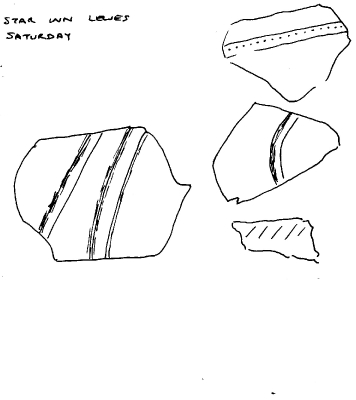 this was found in the pit on the 5th Sept and on the following day viz the 6th I have the following note in my memorandum book. “Excavated bottom of pit 5 & found a quantity of bones and some more pottery at bottom. No oyster shells or helix apersa no implements. rubble mixed and firm and the bones and pottery found more or less all through the fillings.” in short it is quite certain that this pit was the same as the others and the filling being mixed & not white shewed that it was probably filled with rubble that had been some time on the surface. I am sorry to hear that you are not yet relieved from anxiety about the confinement. I will keep the rest of the bones & take them to Guildford & send them to you as soon as you have leisure to look them over.
this was found in the pit on the 5th Sept and on the following day viz the 6th I have the following note in my memorandum book. “Excavated bottom of pit 5 & found a quantity of bones and some more pottery at bottom. No oyster shells or helix apersa no implements. rubble mixed and firm and the bones and pottery found more or less all through the fillings.” in short it is quite certain that this pit was the same as the others and the filling being mixed & not white shewed that it was probably filled with rubble that had been some time on the surface. I am sorry to hear that you are not yet relieved from anxiety about the confinement. I will keep the rest of the bones & take them to Guildford & send them to you as soon as you have leisure to look them over.
Yours sincerely
A Lane Fox
----
[illegible] 10th 77 [1]
Guildford
Dear Professor Rolleston
Under the circumstances I will put off my visit to Oxford as you suggest.
Will it not be best to draw ask for another grant for your cave explorations at Tenby [1] & to ask also for another 20 or 30 £ for the exploration of British earthworks.
I think the British earthworks [illegible, looks like I-G] Camps is a very useful grant for the Association [2] to give because we are greatly in want of information about them and there are no relics to be found in them which will repay any private individual for expending money upon them therefore if you approve as I hope you will this British Camp Grant should be kept distinct from the Grant for cave or tumuli
Yours [illegible]
A Lane Fox
[1] Rolleston and Lane Fox published a report in 1878 of a committee on which they both sat of the British Association to examine two caves containing human remains near Tenby. This is probably more likely that this letter dates from 1878 though it seems to read ‘77’
[2] Presumably the BAAS
----
Additional Pitt-Rivers' related material in the Rolleston papers, Ashmolean Museum:
GR/B/1/4
Barrows Dorset
[insert on top in pencl] Fordington Field Barrow [end insert]
Copy
Dorchester July 24 1880
Dorset
Dear Sir
As August is approaching I must send a line to ask if you & General Lane Fox are likely to come here to open the Long Barrow so I think I have plenty of matter respecting the British inhabitants of this neighbourhood to interest you in addition. If you are writing to the General wd. you kindly get his permission for me to make a few excavations on the hill above the Cerne Giant. I believe it is his property. The Dorset Field Club meet at Cerne next month & I wish to have some information for them of course I get the tenant's permission & make all good again.
I am Dear Sir
Yrs truly
Ed. Cunnington
George Rolleston Esq M.D. &c&c
[this seems to follow earlier correspondence between Cunnington and Rolleston regardingn Fordington Field Barrow and other Dorset barrows]
----
GR/B/4/13
Archaeological Finds Sussex
'As regards the two collections of Bones [insert] and shells [end insert] examined by me from Caesar's Camp & Mount Caburn respectively. I have to say that they agree with each other in the following points
They both consist of domestic as opposed to wild mammals, and of some few skulls which must have been used for food, oysters, whelks cockle [insert] limpet [end insert] and mussel. With these are mixed up in great abundance Helix asp... [illegible] & [illegible] and Cyclostornia [illegible] in less quantity; these shells having possibly found their way into the pits accidentally.
[Followed by rough notes by Rolleston]
[Then a "List of bags of bones sent to Professor Rolleston' written by Lane Fox]
[Then series of notes on Cissbury by Rolleston regarding skeletal remains, one dated April 1878, another April 5 1878, including drawings of strat. layers, some notes by J. Park Harrison and also letters from Charles Kelly]
If you wish to arrange to see the originals or to discuss the content further then please contact the Department of Antiquities at Tel: +44 (0)1865 278020 Email: This email address is being protected from spambots. You need JavaScript enabled to view it.
Transcribed by Alison Petch, January 2012.All 'footnotes' are hers, the letters have been transcribed as they are and not edited.
We are very grateful to the Ashmolean Museum for allowing us to place transcriptions on this website and wish to thank Alison Roberts in particular for her help in this matter. We are also very grateful to Alice Stevenson who at the time of transcription was working on the Rolleston manuscripts for the Ashmolean Museum.

